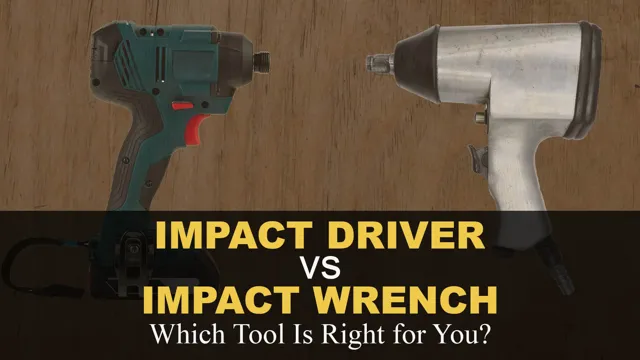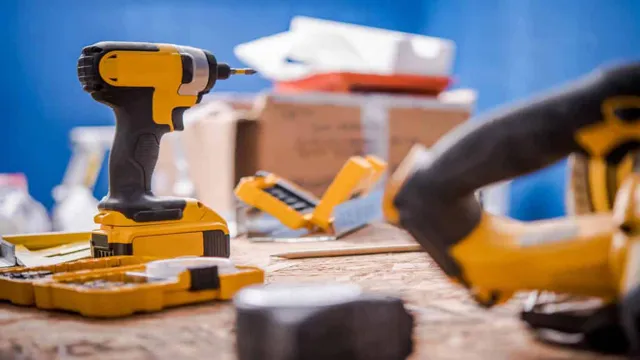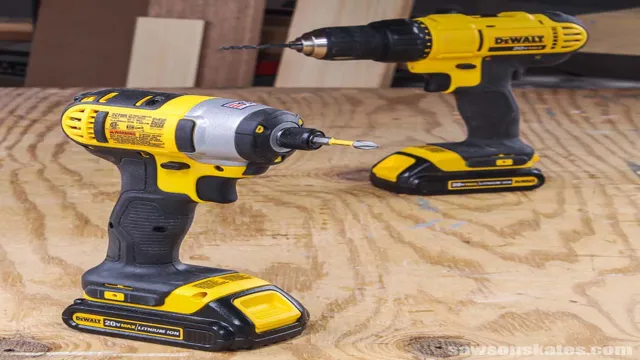Can You Use an Impact Driver for Drywall? Pros, Cons and Tips

Drywall installation can be a challenging task, requiring significant time, precision, and skill. While using traditional tools like a drill can help, some DIY enthusiasts are looking for faster and more effective methods. One of these methods involves using an impact driver for drywall installation.
However, the question on everyone’s mind is, “Is it a good idea?”. This blog delves into the pros and cons of using an impact driver for drywall, helping you make an informed decision. So, whether you’re a DIY beginner or seasoned professional, keep reading to discover the benefits and potential pitfalls of utilizing this powerful tool for your next drywall project.
Introduction
If you’re wondering if you can use an impact driver for drywall, the answer is yes! Impact drivers are a handy tool that can save you time and energy when working on drywall. They are powerful, efficient, and designed specifically for driving screws into thick materials like wood and metal. However, it’s important to keep in mind that impact drivers are not designed specifically for drywall installation.
While they can certainly be used for the task, there are some things you should keep in mind to ensure a successful installation. For example, you should use special drywall screws that are designed to prevent cracking, and you should be careful not to overdrive the screws as this can cause the drywall to crack or buckle. Overall, using an impact driver for drywall installation can be a great way to speed up the process and achieve professional-looking results.
Defining an Impact Driver and Its Uses
An impact driver is a handheld tool designed for driving and removing screws, bolts, and nuts with high torque and force. It is similar to a cordless drill, but with more power and faster rotation speed. Impact drivers are used in construction, woodworking, and automotive repair applications, where a lot of driving and removing is required.
The tool operates by applying concussive force directly to the fastener as it spins, which makes it easier to drive into hard materials without causing damage. Impact drivers come in various sizes and shapes, making them useful in different applications. If you want to complete your DIY projects with ease and efficiency, you need to invest in a top-quality impact driver.
It is easy to use, powerful, and versatile, making it an essential tool for both professionals and DIY enthusiasts. Its compact size and lightweight design make it easy to carry around, while its high-torque output and variable speed control make it suitable for different tasks. Whether you are driving screws into hardwood, assembling furniture, or removing lug nuts on your car, an impact driver is designed to make the job easier and faster.
Therefore, if you want to get the job done quickly and efficiently, an impact driver is the perfect tool for the job.

Common Tools Used for Drywall Installation
Drywall installation is a task that requires specific tools and equipment to be done successfully. Without the proper tools, installing drywall can become a frustrating and challenging experience. There are many tools available on the market today that can make the process a lot easier and efficient.
Some of the most frequently used tools for drywall installation include a measuring tape, utility knife, drywall saw, screw gun, and T-square. Each of these tools plays a vital role in the installation process, and they need to be used correctly to get the job done correctly. A measuring tape ensures accurate cuts, a utility knife helps to score and cut the drywall panels, a drywall saw helps to cut out holes and other shapes, a screw gun helps to secure the drywall in place, and a T-square ensures straight and square lines.
Investing in quality tools for drywall installation can make all the difference in the final result.
Can You Use an Impact Driver for Drywall?
Yes, you can use an impact driver for drywall, but it’s not the best option. While an impact driver may seem like a powerful tool for driving screws into drywall, it can end up causing more problems. The force generated by an impact driver can strip the screws or even split the drywall if you’re not careful.
Additionally, the clutch system on an impact driver can be too powerful for installing screws into drywall. It’s best to use a drywall screw gun, which is specially designed for installing drywall screws without damaging the surface. These guns have adjustable depth settings and a protective nosepiece that prevents overdriving the screws.
Using a drywall gun will save you time and ensure that your drywall installation is done properly without any mistakes. So, while an impact driver can be used, it’s not the ideal tool for the job.
Advantages and Disadvantages of Using an Impact Driver for Drywall
Using an impact driver for drywall can be a time-saving option for both professional and DIYers. The tool’s high torque ensures fast and easy installation of drywall screws, making the job more efficient. However, there are some advantages and disadvantages to consider before using an impact driver.
One of the advantages is that it can handle tough and dense materials, such as thicker drywall and plywood, without difficulty. Additionally, the impact driver’s powerful force can sink screws deeper into the drywall, providing a more secure attachment. On the other hand, one disadvantage of using an impact driver is its loud noise and intense vibration, which can cause discomfort to the user after prolonged use.
Furthermore, the tool’s power can lead to overdriving screws and damaging the drywall, requiring repair work to fix. Therefore, when using an impact driver for drywall, it’s essential to have experience handling the tool and practice caution to avoid any unwanted issues.
Factors to Consider Before Using an Impact Driver for Drywall
If you’re wondering whether or not you can use an impact driver for drywall, the answer is yes, but with some considerations. Impact drivers can work well with drywall if used correctly, but there are a few factors to take into account before doing so. First and foremost, make sure you choose the right type of driver bit for your specific drywall job.
Next, consider the amount of torque being applied, as too much pressure may cause damage to the drywall or create screw pops. It’s also essential to adjust the depth settings on your impact driver to prevent overdriving screws or causing the drywall to buckle. Lastly, wearing ear protection is recommended as impact drivers can be quite loud and cause hearing damage.
With these considerations in mind, an impact driver can be an excellent tool for drywall projects, making installation faster and more efficient. Nonetheless, it’s important to ensure the job is done correctly to avoid costly mistakes.
Safety Precautions When Using an Impact Driver for Drywall
If you’re wondering if you can use an impact driver for drywall, the answer is yes. In fact, an impact driver can make the job of hanging drywall much easier and faster. However, it’s essential to take some safety precautions when using one.
First, wear protective gear, including eye and ear protection, as well as gloves. It’s also crucial to ensure that the drywall is secured properly, and there are no obstructions behind the surface you’re working on. Additionally, use the right bit size suitable for the screws you’re using to avoid stripping or breaking them.
Lastly, always handle your impact driver with care and avoid pushing it beyond its limits. By following these safety measures, you can use your impact driver safely to complete your drywall project efficiently.
Alternatives to Using an Impact Driver for Drywall
Yes, you can use an impact driver for drywall, but it might not be the most optimal choice. An impact driver has high torque, which makes it easy to drive screws quickly, but it can also cause damage to the drywall if you’re not careful. Alternatives to using an impact driver for drywall include using a drywall screw gun, which is designed specifically for this task and has a depth adjustment feature to prevent over-driving screws.
Another option is to use a cordless drill with a clutch setting, which allows you to set the torque according to the thickness of the drywall. This way, you can avoid breaking the paper covering the drywall or driving screws too far into the wall. Ultimately, the choice of tool depends on your personal preference and experience, but it’s always a good idea to practice on a smaller project first.
Using a Screwdriver for Drywall Installation
When it comes to drywall installation, using an impact driver might seem like the go-to solution for many DIY enthusiasts out there. However, if you don’t happen to have one on hand, don’t fret. There are alternatives that can work just as well, such as a trusty old screwdriver.
While it may not be as fast as an impact driver, a screwdriver will still get the job done with the right technique. The key is to use the right screws and apply the right amount of pressure to ensure that they are securely anchored without damaging the drywall. Plus, using a screwdriver allows for greater control and precision, making it ideal for smaller projects or hard-to-reach areas.
So, while an impact driver may be the quicker option, a trusty screwdriver can still be a reliable alternative when it comes to drywall installation.
Using a Drill for Drywall Installation
When it comes to drywall installation, an impact driver is often the first tool that comes to mind. However, using a drill can also be a viable alternative for drywall installation. Rather than driving screws in with quick and forceful bursts, a drill can provide a gentler touch, allowing for more precise control.
This is particularly useful if you’re working with delicate materials or in tight spaces where an impact driver may not fit. Additionally, drills are often more versatile than impact drivers, able to handle a wider variety of tasks beyond just driving screws. While they may not be as powerful as an impact driver, drills can still get the job done with ease, making them a valuable tool for any DIY enthusiast or professional contractor.
So next time you’re considering installing drywall, don’t overlook the humble drill as a powerful alternative.
Conclusion
In conclusion, asking whether you can use an impact driver for drywall is like asking if you can use a sledgehammer to hammer in a nail. Technically, yes, you could make it work, but the result may not be pretty. So while an impact driver may be able to do the job in a pinch, it’s not the ideal tool for the job.
Stick to a drywall screw gun or a drill with a clutch for the best results. Save the impact driver for those heavyweight DIY projects.
FAQs
What is an impact driver?
An impact driver is a tool used for driving screws and bolts into various materials, using a combination of rotational force and concussive blows.
What makes an impact driver different from a regular drill?
An impact driver has a unique mechanism that delivers higher torque output with less effort from the user, making it ideal for heavy-duty tasks like driving long screws or bolts.
Can an impact driver be used for drywall installation?
Yes, an impact driver can be used for drywall installation, as long as the appropriate drill bit or driver tip is used to avoid damaging the drywall.
What type of driver tip is best for installing drywall with an impact driver?
A Phillips #2 driver tip is the most commonly used for drywall installation with an impact driver, as it provides the right amount of torque and depth control for the job.
Is an impact driver more effective than a regular drill for drywall installation?
Yes, an impact driver is generally more effective and efficient than a regular drill for drywall installation, as it can deliver higher torque output with less effort from the user.
What safety precautions should be taken when using an impact driver for drywall installation?
Eye protection is always recommended when using power tools, and gloves can also help prevent hand injuries. Additionally, it’s important to use the correct driver tip and to follow manufacturer instructions for safe use.
Can an impact driver be used for other home improvement tasks besides drywall installation?
Yes, an impact driver is a versatile tool that can be used for a variety of tasks, including drilling, driving screws and bolts, and even removing rusted or stripped fasteners.



